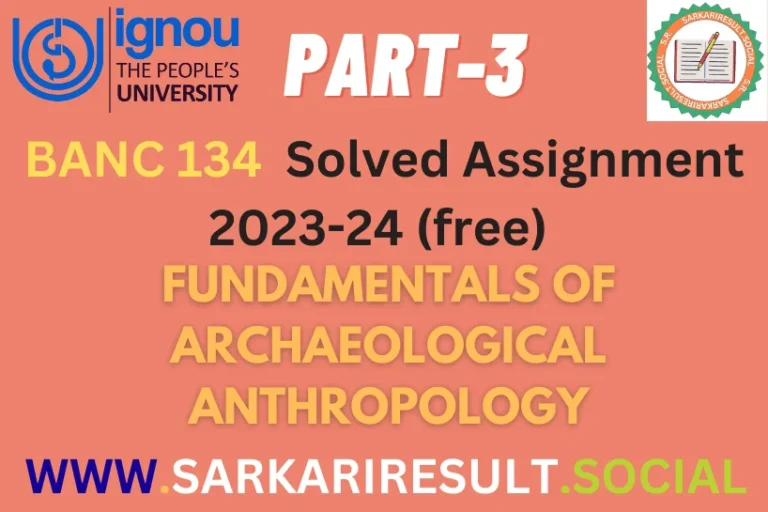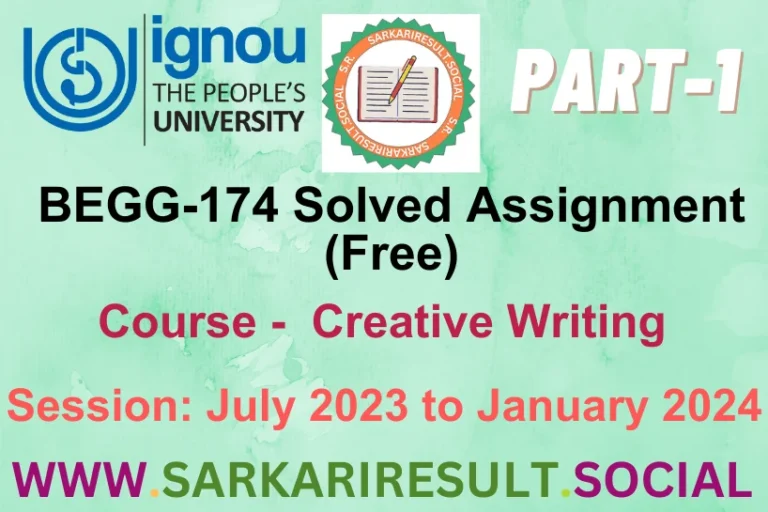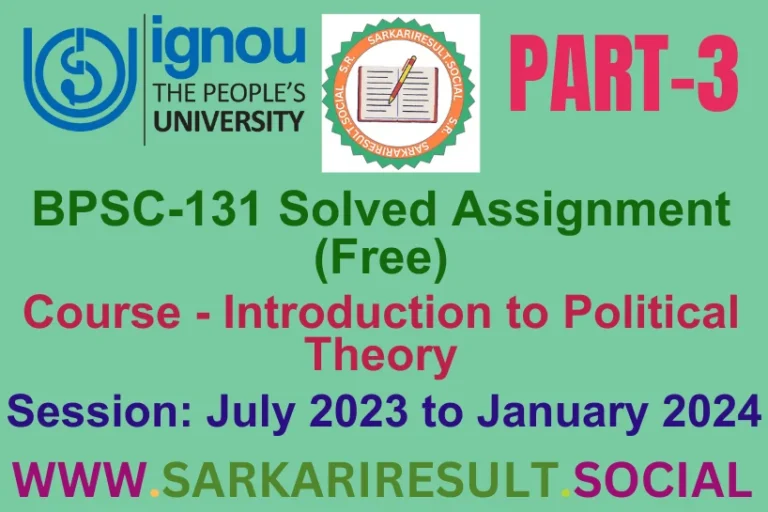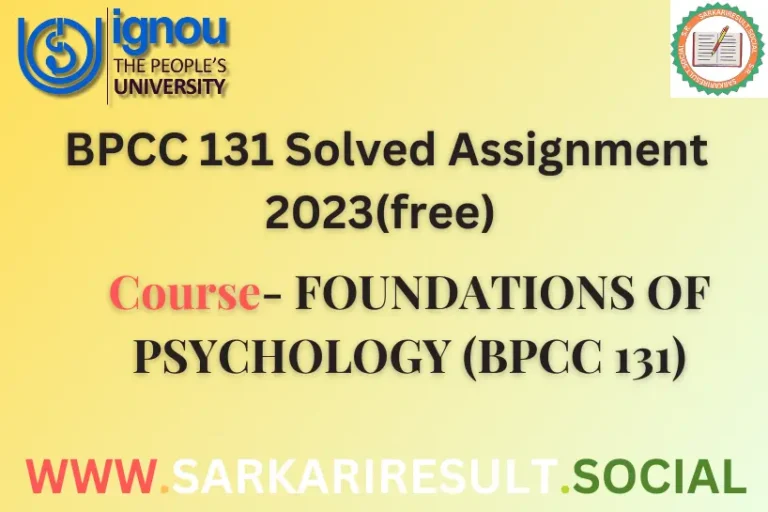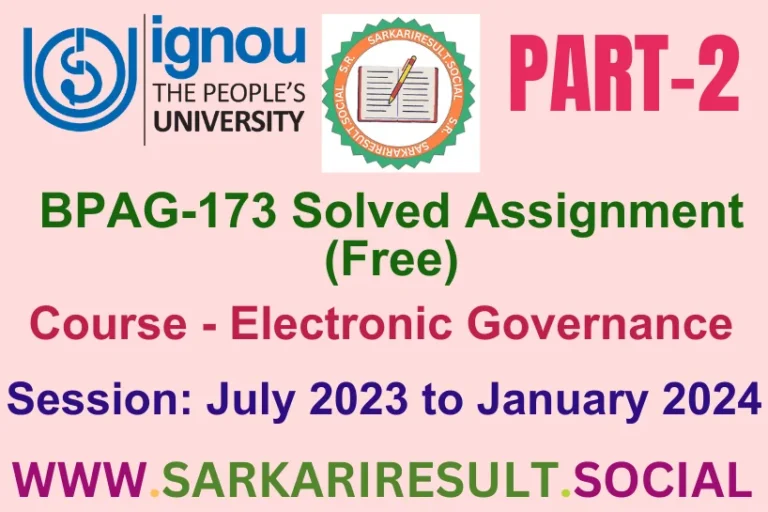MPCE 012 IGNOU Solved Assignment 2023-24 (free) Part 1
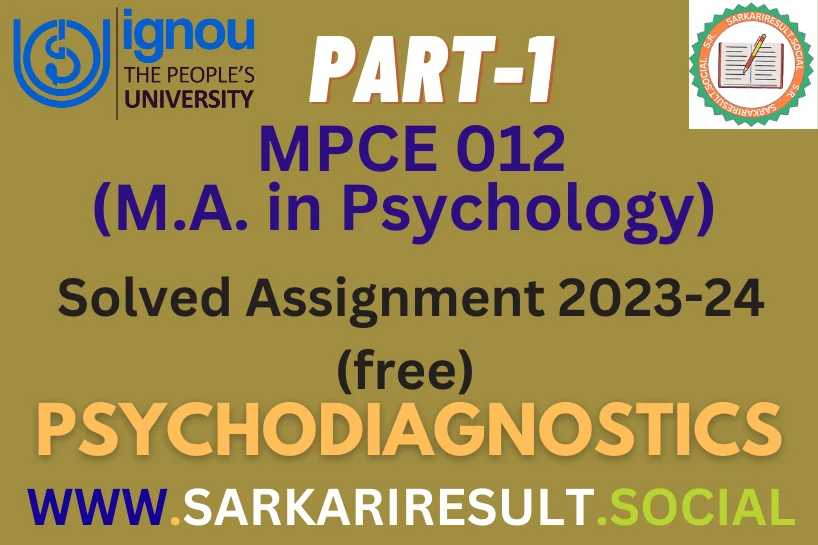
MPCE 012 IGNOU Solved Assignment 2023-24 (free) Part 1
“Explore Psychodiagnostics MPCE 012 IGNOU Solved Assignment 2023-24 (free) Part 1. In Section – A, answer these questions comprehensively with 1000 words each.

Q.1 Discuss the practical application of psychological assessment.
Ans. Practical Application of Psychological Assessment:- Psychological assessment plays a vital role in understanding and addressing a wide range of psychological, emotional, and behavioral issues in individuals. It involves the systematic collection and analysis of information to make informed decisions, diagnose mental health conditions, and develop effective treatment plans. In this discussion, we’ll explore the practical application of psychological assessment in various contexts.
1. Clinical Diagnosis and Treatment Planning:
Psychological assessment is fundamental in clinical psychology and psychiatry. When an individual seeks help for emotional or behavioral difficulties, assessments help clinicians:
BANC 132 IGNOU Solved Assignment 2023-24 (free) Part-1
– Diagnose Mental Disorders: Through structured interviews, self-report questionnaires, and observation, clinicians can determine the presence and severity of mental health conditions, such as depression, anxiety disorders, schizophrenia, or personality disorders.
– Assess Suicide Risk: Risk assessments, like the Columbia-Suicide Severity Rating Scale, are used to evaluate an individual’s potential for self-harm or suicide, allowing for immediate intervention when necessary.
– Formulate Treatment Plans: Assessment results guide the development of tailored treatment plans, which may include therapy approaches (e.g., cognitive-behavioral therapy, psychoanalysis) and medications (prescribed by psychiatrists).
– Monitor Progress: Ongoing assessments track an individual’s progress during treatment, helping clinicians make adjustments as needed to improve outcomes.
2. Educational Assessment and Intervention:
In education, psychological assessment serves various purposes:
– Identifying Learning Disabilities: Assessments like the Wechsler Intelligence Scale for Children (WISC) and Woodcock-Johnson Tests can identify specific learning disabilities (e.g., dyslexia) and guide educators in providing appropriate support and accommodations.
– Individualized Education Plans (IEPs): Assessment results inform the development of IEPs, which outline special education services and accommodations to meet the unique needs of students with disabilities.
– Gifted Education: Assessments help identify gifted students who may require more challenging educational opportunities.
– Career Counseling: Career assessments (e.g., Strong Interest Inventory) aid in career exploration by matching an individual’s interests and aptitudes with potential career paths.
BANC 132 IGNOU Solved Assignment 2023-24 (free) Part-2
3. Neuropsychological Assessment:
Neuropsychological assessments evaluate cognitive functioning and identify brain-related deficits in individuals with neurological conditions or injuries. Practical applications include:
– Traumatic Brain Injury (TBI): Assessments like the Neuropsychological Assessment Battery (NAB) help determine the cognitive impact of TBI and guide rehabilitation efforts.
– Dementia Diagnosis: Neuropsychological tests, such as the Mini-Mental State Examination (MMSE), are used to assess memory, attention, and problem-solving skills in individuals suspected of having dementia.
– Stroke Rehabilitation: Assessments can identify cognitive deficits resulting from a stroke and inform rehabilitation strategies.
4. Forensic Assessment:
In legal settings, psychological assessments are used for various purposes:
– Competency Evaluations: Assessments determine an individual’s competence to stand trial and their ability to understand legal proceedings and assist in their own defense.
– Criminal Responsibility: Assessments examine whether a defendant’s mental state at the time of the crime negates criminal responsibility (insanity defense).
– Risk Assessments: Assessments like the Violence Risk Appraisal Guide (VRAG) evaluate an individual’s risk of future violent behavior, aiding in sentencing and parole decisions.
– Child Custody Cases: Psychological assessments help determine the best interests of the child in custody disputes.
BANC 132 IGNOU Solved Assignment 2023-24 (free) Part-3
5. Employee Selection and Organizational Development:
Psychological assessments are employed in the business world to make informed decisions regarding hiring, training, and organizational development:
– Pre-Employment Screening: Assessments assess job applicants’ personality traits, skills, and cognitive abilities to determine their suitability for a particular position.
– Leadership Development: Assessments like the 360-degree feedback survey help identify leadership strengths and areas for improvement in individuals and guide leadership development programs.
– Employee Well-Being: Assessments can gauge employee satisfaction, stress levels, and burnout risks, informing strategies to improve workplace well-being.
6. Mental Health Screening and Prevention:
Psychological assessments have a role in mental health screening and preventive efforts:
– Community Mental Health: Screening tools, such as the Patient Health Questionnaire (PHQ-9), are used in community health settings to identify individuals at risk of mental health issues and connect them with appropriate services.
– Early Intervention: Assessments in schools or primary care settings can detect early signs of mental health problems in children, enabling early intervention and support.
– Disaster Response: After natural disasters or traumatic events, psychological assessments are used to assess and address the mental health needs of affected populations.
BANC 131 IGNOU Solved Assignment 2023-24 (free) Part-1
7. Research and Academic Advancements:
Psychological assessments are critical in advancing our understanding of human behavior and cognition:
– Psychological Research: Researchers use assessments to measure variables, test hypotheses, and gather data to support or refute theories.
– Academic Evaluation: Psychological tests and assessments are used to evaluate the effectiveness of educational programs and interventions.
– Psychometric Development: Continuous research leads to the creation of new and improved assessment tools, enhancing the field of psychological testing.
In summary, psychological assessment has wide-ranging practical applications across clinical, educational, legal, organizational, and research domains. It aids in diagnosis, treatment planning, educational support, legal decision-making, employee selection, and much more, ultimately improving individuals’ lives and contributing to our understanding of human behavior and cognition.
Q.2 Explain the purpose of diagnostic assessment. Discuss the areas to be covered in a diagnostic interview.
Ans. Purpose of Diagnostic Assessment:
Diagnostic assessment in the field of psychology and mental health serves several crucial purposes. Its primary aim is to gather comprehensive information about an individual’s psychological, emotional, and behavioral functioning to make an accurate diagnosis. The following are key purposes of diagnostic assessment:
1. Diagnosis: The primary purpose of diagnostic assessment is to determine whether an individual meets the criteria for a specific mental health disorder or condition as outlined in diagnostic manuals such as the Diagnostic and Statistical Manual of Mental Disorders (DSM-5) or the International Classification of Diseases (ICD-10/11). Diagnosis guides treatment planning and informs the selection of appropriate interventions.
2. Treatment Planning: Once a diagnosis is established, diagnostic assessment helps clinicians develop individualized treatment plans tailored to the client’s specific needs. It informs decisions regarding therapeutic approaches, medication management, and other interventions.
3. Prognosis: Diagnostic assessment provides insight into the expected course and outcome of a mental health condition. It helps clinicians predict the likely trajectory of the disorder and assess the potential for recovery or symptom management.
4. Treatment Evaluation: Throughout the course of treatment, diagnostic assessment is used to monitor progress and evaluate the effectiveness of interventions. It enables clinicians to make adjustments to treatment plans based on a client’s response to therapy.
5. Screening and Early Intervention: Diagnostic assessment can serve as an initial screening tool to identify individuals who may be at risk for mental health issues. Early intervention can prevent the exacerbation of symptoms and promote timely access to appropriate care.
BANC 131 IGNOU Solved Assignment 2023-24 (free) Part-2
6. Research and Epidemiology: Diagnostic assessment tools and data contribute to research on the prevalence, causes, and outcomes of mental health disorders. This research informs public health policies, treatment guidelines, and the development of new interventions.
Areas Covered in a Diagnostic Interview:
A diagnostic interview is a structured conversation between a clinician (e.g., psychologist, psychiatrist, social worker) and an individual seeking psychological assessment or treatment. It is a critical component of the diagnostic assessment process, providing valuable information to formulate diagnoses and treatment plans. Here are the key areas typically covered in a diagnostic interview:
1. Presenting Concerns and History: The interview begins with the individual describing their current symptoms, concerns, and reasons for seeking assessment or treatment. A detailed history of the individual’s mental health symptoms, including their onset, duration, and progression, is explored.
2. Personal History: Clinicians gather information about the individual’s personal background, including age, gender, marital status, education, employment, and living situation. This helps establish a contextual understanding of the person’s life circumstances.
3. Medical History: A comprehensive medical history is essential to rule out physical conditions that may contribute to or mimic mental health symptoms. Information about past and current medical conditions, medications, surgeries, and allergies is collected.
4. Psychiatric History: The individual is asked about their history of mental health treatment, including any prior diagnoses, hospitalizations, and experiences with psychiatric medications or therapy.
5. Family History: Clinicians inquire about the mental health history of the individual’s immediate family members (parents, siblings, children), as certain mental health conditions may have a genetic component.
6. Social History: This includes questions about the individual’s social relationships, support systems, social roles, and significant life events (e.g., trauma, loss, major life changes). It helps assess the impact of social factors on mental health.
7. Developmental and Educational History: For children and adolescents, clinicians gather information about developmental milestones, educational experiences, and any learning or developmental disorders.
8. Substance Use History: Individuals are asked about their use of alcohol, drugs, or other substances, as substance abuse or dependence can co-occur with mental health disorders.
9. Cultural and Ethnic Considerations: Cultural factors, including cultural identity, beliefs, and traditions, are explored to understand how they may influence the individual’s mental health and experiences.
BANC 131 IGNOU Solved Assignment 2023-24 (free) Part-3
10. Mental Status Examination: This part of the interview involves the clinician’s direct observation of the individual’s current mental state. It assesses aspects such as appearance, mood, affect, thought content, cognition, and insight.
11. Assessment of Symptoms: Detailed questions are asked to assess the presence and severity of specific symptoms associated with various mental health disorders. These may include symptoms of depression, anxiety, psychosis, obsessive-compulsive behaviors, or trauma-related symptoms.
12. Suicide and Self-Harm Assessment: Clinicians assess the individual’s current risk of self-harm or suicide, including any suicidal thoughts, intent, or previous suicide attempts. This assessment is crucial for safety planning.
13. Safety and Risk Assessment: Beyond suicide risk, clinicians evaluate other potential risks, such as harm to others, substance abuse, or risky behaviors that may impact the individual’s safety.
14. Diagnostic Formulation: Based on the information gathered during the interview, the clinician formulates a diagnostic impression or differential diagnosis. This involves considering potential mental health conditions that may explain the individual’s symptoms.
15. Collateral Information: In some cases, clinicians may seek collateral information from sources such as family members, teachers, or previous treatment providers to gain a more comprehensive understanding of the individual’s history and functioning.
16. Feedback and Treatment Planning: The clinician provides feedback on the diagnostic impression and collaborates with the individual to develop a treatment plan. Treatment options, goals, and expectations are discussed.
17. Informed Consent: The individual is informed about the assessment process, treatment options, confidentiality, and any potential risks or benefits. Informed consent is obtained before proceeding with any recommended interventions.
A comprehensive diagnostic interview is a dynamic and collaborative process that requires skillful communication and empathetic listening on the part of the clinician. It serves as the foundation for effective mental health assessment and the development of individualized treatment plans aimed at promoting mental well-being and recovery.
Q.3 Examine the tests of implicit memory and explicit memory.
Ans. Tests of Implicit Memory and Explicit Memory
BEGAE 182 IGNOU Solved Assignment 2023-24 (free)
Memory is a complex cognitive function that involves the storage and retrieval of information. Researchers have identified two main types of memory: implicit memory and explicit memory. These memory systems operate differently and can be assessed through various tests and experiments. In this examination, we will explore these memory types and the tests used to measure them.
Implicit Memory:
Implicit memory refers to the unconscious or unintentional influence of past experiences on current behavior or cognitive processing. It operates without our awareness and does not require conscious effort to retrieve information. Implicit memory is often revealed through changes in behavior, performance, or attitudes that have been influenced by prior experiences. Here are some common tests and examples of implicit memory:
1. Word Stem Completion Task: In this task, participants are given word stems (e.g., “fl__”) and asked to complete them to form words. They often complete the stems with words that they have encountered recently, even if they don’t consciously remember seeing those words. This demonstrates how prior exposure influences their word choices.
2. Priming: Priming is a common method to test implicit memory. Participants are presented with a stimulus (e.g., a word, image, or sound) that is intended to activate related concepts or information. Later, they are asked to perform a task (e.g., word recognition or naming) in which the primed information influences their responses, even though they may not consciously recall the initial stimulus.
3. Mirror Reading Task: In this task, participants are asked to read text that is presented in a mirror-reversed or distorted format. Initially, they may struggle, but with practice, they improve. This improvement is due to implicit learning of the patterns and configurations of the distorted text.
4. Serial Reaction Time Task: This task assesses implicit learning of motor sequences. Participants are asked to respond to visual or auditory cues by pressing specific keys in a sequence. Over time, they become faster and more accurate in responding, indicating that they have learned the sequence implicitly.
5. Classical Conditioning: Classical conditioning, famously demonstrated by Pavlov’s dogs, is a form of implicit memory. In this paradigm, a neutral stimulus (e.g., a bell) is paired with an unconditioned stimulus (e.g., food) to elicit a conditioned response (e.g., salivation) over time. This learned association occurs implicitly.
Implicit memory is thought to be mediated by various brain regions, including the basal ganglia and the cerebellum. It is responsible for various automatic and habitual behaviors and contributes to skills and habits formed through practice and repetition.
Explicit Memory:
Explicit memory, in contrast, involves the conscious, intentional, and deliberate retrieval of information from memory. It requires individuals to be aware that they are trying to remember something and to use cognitive processes to bring that information into conscious awareness. Explicit memory is assessed through tests that directly ask individuals to recall or recognize information. Here are common tests and examples of explicit memory:
1. Free Recall Test: In a free recall test, participants are asked to remember as many items as possible from a list they have previously seen or heard. For example, after viewing a list of words, they must recall as many of those words as they can, in any order.
2. Cued Recall Test: Cued recall provides participants with cues or hints to help them remember information. They are given a cue or a portion of the target information and are asked to recall the associated item. For instance, participants might be given the cue “Fruit: _ _ _ _ _” to help them remember the word “banana.”
3. Recognition Test: In recognition tests, participants are presented with a set of items, some of which they have seen or heard before (targets) and some of which are new (distractors). They must indicate which items they remember encountering previously.
4. Episodic Memory Tasks: Episodic memory involves remembering specific events or episodes from one’s life. Participants may be asked to recall details from a personal event, such as a birthday party, a vacation, or a significant life moment.
5. Semantic Memory Tests: Semantic memory refers to the knowledge of facts and concepts not tied to specific personal experiences. Participants are assessed on their ability to recall or recognize general knowledge, such as historical events, capital cities, or scientific facts.
6. Prospective Memory Tests: Prospective memory involves remembering to perform intended actions at specific future times or in specific situations. Participants might be given a task to complete later, such as remembering to call someone at a particular time.
7. Recollection vs. Familiarity: Explicit memory tests can also distinguish between recollection (the ability to remember specific details about an event or item) and familiarity (the sense of having encountered something before without remembering specific details). These distinctions provide insights into the quality of explicit memory retrieval.
Explicit memory relies on the medial temporal lobe, particularly the hippocampus, as well as other cortical regions. The hippocampus plays a crucial role in the formation and consolidation of explicit memories, allowing us to consciously recall facts, events, and experiences.
Interaction between Implicit and Explicit Memory:
It’s important to note that implicit and explicit memory systems are not entirely separate; they can interact in various ways:
1. Priming Effects: Implicit memory can influence explicit memory. For example, if individuals are primed with related information implicitly, they may later find it easier to explicitly recall or recognize related items.
2. Skill Learning: Skills acquired implicitly through practice and repetition can become explicit over time. As individuals gain expertise in a particular domain, they may be able to consciously articulate and explain their skills and knowledge.
3. Dual-Process Models: Some theories propose that both implicit and explicit memory systems operate concurrently and contribute to memory processes. For instance, the dual-process model of recognition memory suggests that familiarity (implicit) and recollection (explicit) processes both play a role in recognizing previously encountered items.
In summary, implicit and explicit memory are distinct memory systems with unique characteristics and functions. While implicit memory operates unconsciously and influences behavior and performance, explicit memory involves conscious awareness and deliberate retrieval of information. Both memory systems contribute to our ability to remember and interact with the world around us, and they can interact and influence each other in various ways. Researchers use a range of tests and experiments to investigate these memory systems and their underlying mechanisms.

